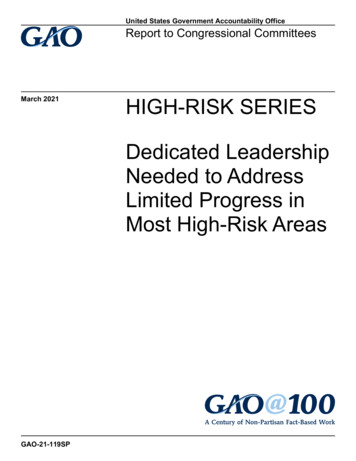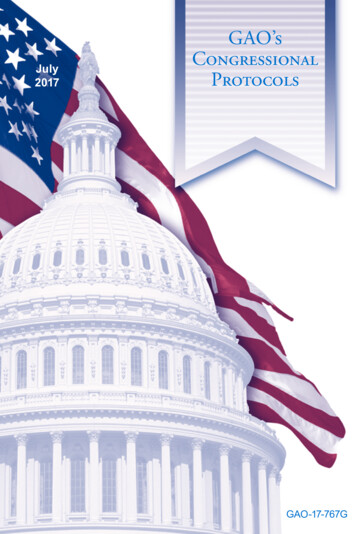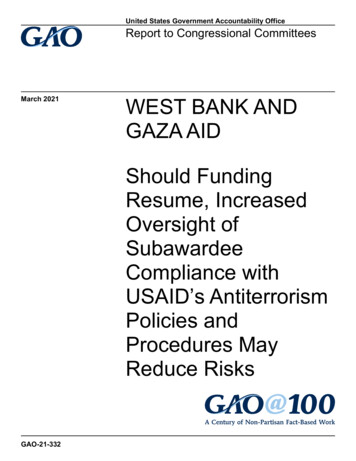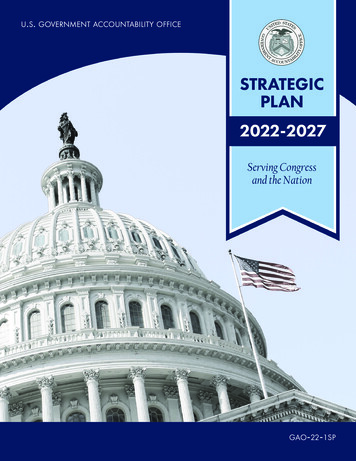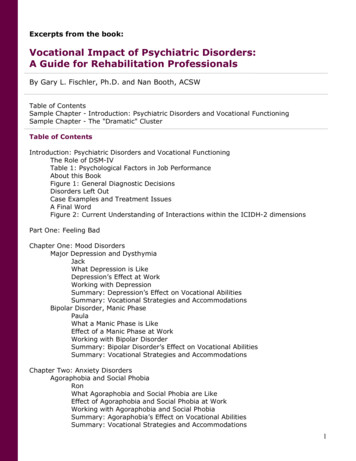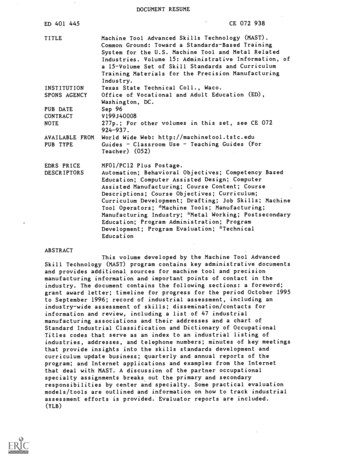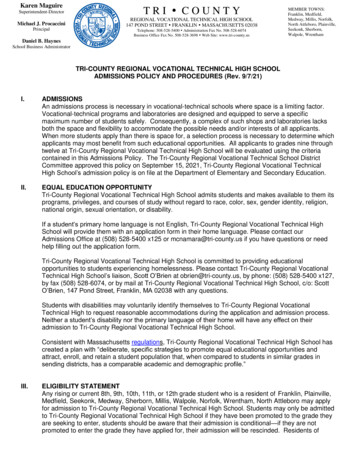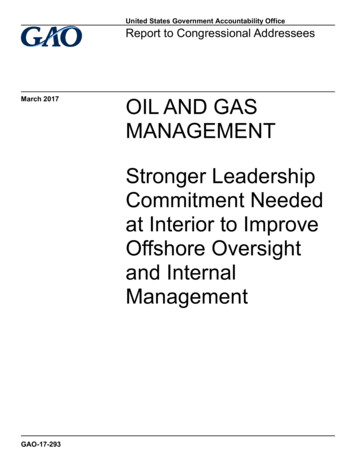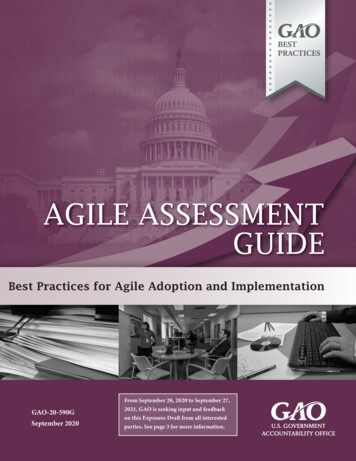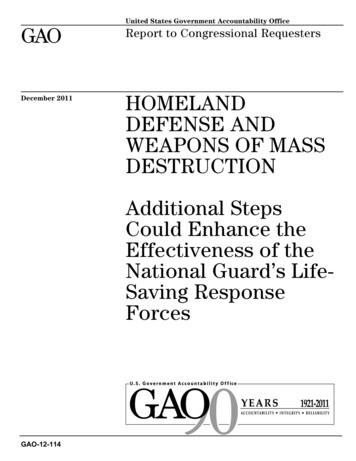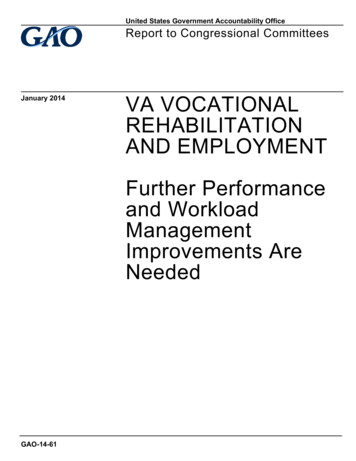
Transcription
United States Government Accountability OfficeReport to Congressional CommitteesJanuary 2014VA VOCATIONALREHABILITATIONAND EMPLOYMENTFurther Performanceand WorkloadManagementImprovements AreNeededGAO-14-61
January 2014VA VOCATIONAL REHABILITATION ANDEMPLOYMENTHighlights of GAO-14-61, a report tocongressional committeesFurther Performance and Workload ManagementImprovements Are NeededWhy GAO Did This StudyWhat GAO FoundVeterans with disabilities face specialchallenges to finding employment—resulting, for example, from theveterans’ physical or mental health, ornegative attitudes or stereotypes onthe part of some employers. VA’sVR&E program aims to help veteranswith disabilities obtain and maintainsuitable employment—compatible withtheir disabilities—through servicessuch as training and job searchassistance. The VOW to Hire HeroesAct of 2011 directed GAO to review theprogram. GAO examined (1) theoutcomes for veterans seekingemployment through the program, and(2) the progress VA has made inaddressing critical managementissues. GAO reviewed relevant laws,regulations, and guidance as well asrecent studies; reviewed variousprogram management criteria;analyzed VA administrative data onveterans who entered the programbetween fiscal years 2003 and 2012;interviewed staff at the VA centraloffice and 8 regional offices;interviewed a random but nongeneralizable sample of 17 programparticipants; and analyzed data from aVA survey of participants.About half of the almost 17,000 veterans who entered the Department ofVeterans Affairs’ (VA) Vocational Rehabilitation and Employment (VR&E)program in fiscal year 2003 and received employment-related services wereplaced in suitable jobs, one-third left the program, and most of the others are stillparticipating. It often took veterans 6 years or more to achieve success (seefigure), due in part to veterans often leaving the program temporarily. Interviewswith VR&E staff and participants and administrative data GAO reviewed suggestveterans face numerous challenges that affect their ability to obtain employment,especially related to mental health conditions, working with multiple VR&Ecounselors over time, and civilian employers’ limited understanding of militarywork experience.What GAO RecommendsGAO recommends that VA reflectsuccess rates in revised performancemeasures, ensure the reliability of itscustomer satisfaction survey results,re-visit its staff allocation formula,study staff assignments, and closecertain gaps in its training for staff. Inits comments, VA generally concurredwith these recommendations andnoted steps it plans to take to addressthem.View GAO-14-61. For more information,contact Daniel Bertoni (202) 512-7215 orbertonid@gao.govTime to Achieve Suitable Employment for Fiscal Year 2003 ApplicantsVA has taken steps to improve VR&E performance management, workloadmanagement, and staff training, but weaknesses remain. With regard toperformance management, VA has an ongoing initiative to revise its approach formeasuring rehabilitation success at the individual employee, regional, andnational levels. However, the new approach VA is considering for employeesreflects only the number, not the rate of successful outcomes, and thereforewould not provide sufficient context for understanding program success. VA hasnot yet developed its new approaches for assessing rehabilitation successregionally and nationally. Also, VA began surveying participants’ satisfaction withthe program and plans to use the results to manage performance; while VA hasgenerally followed good survey design practices, the agency has not fullyassessed the reliability of early customer satisfaction results. In terms ofworkload management, VA has taken steps to reduce paperwork burdens onregional offices. However, several offices still reported heavy workloads andnoted that VA’s formula for allocating staff among offices does not consider otherstaff duties affecting workloads, such as education counseling. In addition, VAhas not studied the relative effectiveness and efficiency of regional offices’approaches for assigning staff to manage workloads. Finally, with respect totraining, VA has addressed redundancy and most gaps in training for VR&E staff,but gaps remain in the areas of job placement assistance and workplaceaccommodations.United States Government Accountability Office
ContentsLetter1BackgroundAbout Half of Veterans Seeking Employment Are Successful,Although Program Participants Face Many ChallengesVA Has Made Limited Progress in Improving VR&E PerformanceManagement, Workload Management, and TrainingConclusionsRecommendations for Executive ActionAgency Comments and Our Evaluation21343536Appendix IObjectives, Scope, and Methodology38Appendix IIStatistical Analysis of Administrative Data on VocationalRehabilitation and Employment Outcomes46Vocational Rehabilitation Counselor Training Gaps Identified byVA in 2010 and the Agency’s Efforts to Address55Appendix IVComments from the Department of Veterans Affairs56Appendix VGAO Contact and Staff Acknowledgments60Appendix IIIRelated GAO Products31161TablesTable 1: VA’s Vocational Rehabilitation and EmploymentPerformance Measures, with Fiscal Year 2013 GoalsTable 2: Description of Vocational Rehabilitation andEmployment’s Voice of the Veteran Pilot SurveysTable 3: Sample Outcomes for Vocational Rehabilitation andEmployment’s Voice of the Veteran Pilot SurveysPage i94344GAO-14-61 VA Vocational Rehabilitation and Employment
Table 4: Sample Size by Fiscal Year of Program Entry andOutcomesTable 5: Estimated Hazard Ratios of Time to VocationalRehabilitation and Employment Program Completion4753FiguresFigure 1: Total Vocational Rehabilitation and EmploymentCaseload and Counselors, and Average Caseload, FiscalYears 2008 through 2012, and as of March 2013Figure 2: The Vocational Rehabilitation and Employment Processfrom Application to OutcomeFigure 3: Outcomes to Date for Fiscal Year 2003 Applicants WhoReceived Employment-Related ServicesFigure 4: Time to Achieve Suitable Employment for Fiscal Year2003 ApplicantsFigure 5: Likelihood of Achieving Suitable Employment forVeterans with Selected Disabilities Compared to Thosewith Other DisabilitiesFigure 6: Likelihood of Achieving Suitable Employment forVeterans Working with Multiple CounselorsFigure 7: Regional Office Caseloads for Vocational RehabilitationCounselors—Lowest, Highest and Overall Average—Fiscal Years 2008 through 2012 and March 2013Figure 8: Regional Offices Contacted and Their CharacteristicsPage ii68121316182841GAO-14-61 VA Vocational Rehabilitation and Employment
VR&ECorporate WINRSEmployment coordinatorFull-time equivalentDepartment of Labormaximum rehabilitation gainOffice of Management and BudgetPost-traumatic stress disorderTraumatic brain injuryDepartment of Veterans AffairsVeterans Benefits AdministrationVocational rehabilitation counselorVocational Rehabilitation and EmploymentThis is a work of the U.S. government and is not subject to copyright protection in theUnited States. The published product may be reproduced and distributed in its entiretywithout further permission from GAO. However, because this work may containcopyrighted images or other material, permission from the copyright holder may benecessary if you wish to reproduce this material separately.Page iiiGAO-14-61 VA Vocational Rehabilitation and Employment
441 G St. N.W.Washington, DC 20548January 14, 2014The Honorable Bernard SandersChairmanThe Honorable Richard BurrRanking MemberCommittee on Veterans’ AffairsUnited States SenateThe Honorable Jeff MillerChairmanThe Honorable Michael MichaudRanking MemberCommittee on Veterans’ AffairsHouse of RepresentativesAbout 3 million veterans—including more than 700,000 from the Iraq andAfghanistan era—have a disability connected to their military service, 1and many face special challenges obtaining employment. Veterans withdisabilities may face employment challenges related to physicalimpairments, less visible mental health conditions, or negative attitudesand stereotypes among some employers. The Department of VeteransAffairs (VA) operates the Vocational Rehabilitation and Employment(VR&E) program to help veterans with service-connected disabilitiesobtain and maintain suitable employment, which it considers to beemployment consistent with their abilities, aptitudes, and interests. Theprogram provides services including vocational assessment, educationand training, and job placement. In fiscal year 2012, about 121,000veterans participated in the program at a cost of almost 1 billion.To improve the transition of veterans to civilian employment, Congresspassed the VOW to Hire Heroes Act of 2011 (VOW Act). 2 In addition toprovisions intended to promote veterans’ employment, includingexpanded access to VR&E benefits for certain unemployed veterans, the1These data are based on a survey of veterans conducted in August 2012 by the U.S.Census Bureau.2Pub. L. No. 112-56, tit II, 125 Stat. 711, 712.Page 1GAO-14-61 VA Vocational Rehabilitation and Employment
VOW Act mandated that GAO review the VR&E program. 3 We examined(1) the outcomes for veterans seeking employment through the VR&Eprogram, and (2) the progress VA has made in addressing criticalmanagement issues. To address these objectives, we reviewed relevantfederal laws, regulations, and guidance as well as documentation relatedto recent management initiatives. We analyzed VA administrative data onVR&E participants who applied to the program between fiscal years 2003and 2012, including their characteristics, services received, and outcomesobtained. We assessed the reliability of these data through electronictesting and interviews with VA staff, and found them sufficiently reliablefor our reporting purposes. We interviewed VA central office staffresponsible for the VR&E program, as well as VR&E managers and staffin 8 of VA’s 57 regional offices. We selected offices to achieve diversity inVR&E caseload, performance in job placement and case processingtimeliness, state unemployment rate, and geographic location. Weconducted phone interviews with a random but non-generalizable sampleof 17 veterans who had participated in the VR&E program and exited witheither a successful or unsuccessful outcome. Finally, we obtainedselected data resulting from a pilot VA customer satisfaction survey thatincludes responses from VR&E participants, after reviewing the survey’smethodology and finding it to be sufficiently reliable for our purposesWe conducted this performance audit from October 2012 to January 2014in accordance with generally accepted government auditing standards.Those standards require that we plan and perform the audit to obtainsufficient, appropriate evidence to provide a reasonable basis for ourfindings and conclusions based on our audit objectives. We believe thatthe evidence obtained provides a reasonable basis for our findings andconclusions based on our audit objectives. Additional information on ourscope and methodology is provided in appendix I.3See id. at § 233(d), 125 Stat. 711, 720.Page 2GAO-14-61 VA Vocational Rehabilitation and Employment
BackgroundVR&E Entitlement andEligibilityTo be entitled to VR&E services and related benefits, veterans generallymust (1) have at least a 20 percent disability rating from the VA 4 and (2)be in need of rehabilitation because of an employment handicap causedin substantial part by a service-connected disability. 5, 6 If needed toachieve employment, entitled veterans may receive a maximum of 48months of vocational rehabilitation services and an additional 18 monthsof employment services, which include counseling, placement, andpostplacement services. 7 Veterans are typically eligible to receive theseservices within a 12-year period beginning on either: (1) the date ofseparation from military service, or (2) the date the veteran received a4VA rates veterans’ disabilities that are incurred or aggravated as a result of their militaryservice, which are referred to by VA as service-connected disabilities, from 0 percent to100 percent in increments of 10 percentage points. A veteran must also have a militarydischarge that is not dishonorable to be eligible for the VR&E program.538 U.S.C. § 3102(a)(1). The law defines an employment handicap as an impairment of aveteran’s ability to prepare for, obtain, or retain employment consistent with the veteran’sabilities, aptitudes, and interests. 38 U.S.C. § 3101(1). Veterans with a 10 percent serviceconnected disability may also be eligible to receive VR&E services if they have a seriousemployment handicap. 38 U.S.C. § 3102(a)(2). A serious employment handicap is definedas a significant impairment of a veteran’s ability to prepare for, obtain, or retainemployment consistent with his or her abilities, aptitudes and interests. 38 U.S.C. §3101(7). The definitions of employment handicap and serious employment handicapprovide that the handicap must result in substantial part from a service-connecteddisability.6Active duty servicemembers may also be eligible for VR&E services under certaincircumstances. For example, servicemembers may qualify if, while awaiting dischargefrom the military, they are hospitalized or receiving outpatient treatment at a VA facility ora facility that is under contract with the VA, have a disability that VA will likely find to beservice-connected with a 20 percent or higher rating, and are determined to be in need ofrehabilitation because of an employment handicap. 38 U.S.C. § 3102(a)(1)(A)(ii) and (B).Until December 31, 2014, servicemembers are entitled to certain VR&E services if theyare seriously ill or injured. Pub. L. No. 110-181, §1631(b)(2), 122 Stat. 3, 458 (2008) (10U.S.C 1071 note) as amended by Pub. L. No. 112-56, § 231, 125 Stat. 711, 719 (2011).738 U.S.C. § 3105(b)(1). Eligible veterans for whom a vocational goal is not currentlyconsidered reasonably feasible may receive assistance intended to help them achieveindependent living. 38 U.S.C. § 3109.Page 3GAO-14-61 VA Vocational Rehabilitation and Employment
disability rating from VA, whichever is later. In certain circumstances, the48-month limit and the 12-year period of eligibility may be extended. 8Availability of AdditionalBenefits pre- and postVOW ActUnder certain circumstances, veterans who have successfully completeda VR&E program and achieved rehabilitation may qualify for additionalVR&E benefits and services. Prior to the VOW Act, veterans whosuccessfully completed a VR&E program could receive additionalservices if (1) their service-connected condition worsened to the extentthat they could no longer perform the duties of the occupation for whichthey were previously rehabilitated, or (2) their occupation was no longersuitable because of their current capabilities and employment handicap. 9The VOW Act created another pathway for previously rehabilitatedveterans to receive additional services. Under section 233 of the VOWAct, veterans who have exhausted their right to regular unemploymentcompensation under state law may receive up to 12 additional months ofVR&E services and benefits following a successful rehabilitation, as longas they are otherwise eligible and they begin the additional programwithin 6 months after they exhausted unemployment compensation. 10This provision took effect on June 1, 2012, and veterans must apply nolater than March 31, 2014 to qualify.Administrative StructureWithin VA’s Veterans Benefits Administration’s (VBA) Office of EconomicOpportunity in Washington D.C., the central VR&E Office is responsiblefor overseeing the VR&E program. VR&E services are provided bymanagers and staff at 57 regional offices and 179 satellite offices, under8The 48-month limit on training services can be extended if, for example, the veteran hasa serious employment handicap and the extension is necessary to accomplish theveteran’s vocational or independent living goal. 38 U.S.C. § 3105(c)(2) and 38 C.F.R. §21.78(c). The 12-year limit on the eligibility period can also be extended for veterans whohave a serious employment handicap and have not previously been rehabilitated to thepoint of employability. 38 U.S.C. § 3103(c)(1) and 38 C.F.R. § 21.44(a)(1).938 C.F.R. § 21.284. Veterans who meet these conditions may receive such additionalservices even if they have previously exhausted their 48-month entitlement to VR&Eservices. 38 U.S.C. § 3105(c)(1). Veterans who meet these conditions and have a seriousemployment handicap may receive such additional services even if they are no longerwithin their 12-year period of eligibility. 38 U.S.C. § 3103(c)(2).10Codified at 38 U.S.C. § 3102(b). Such veterans may receive these additional serviceseven if they have previously exhausted their 48 months of services or are no longer withintheir 12-year eligibility period. 38 U.S.C. §§ 3105(b)(2) and 3103(e).Page 4GAO-14-61 VA Vocational Rehabilitation and Employment
the management of VBA’s central Office of Field Operations, whichmanages workload and performance to achieve targets set incoordination with the central VR&E Office. VR&E positions typicallyinclude (1) a VR&E officer who oversees the VR&E field office and itsstaff; (2) vocational rehabilitation counselors (VRC) who work directly withveterans to assess their entitlement, develop their rehabilitation plans,and manage their progress; (3) employment coordinators (EC) who focuson assisting veterans with job search and placement, which also includesemployer outreach to facilitate contact between veterans and employers;and (4) other staff to support the administration of the program. VR&Efield staff are also located at select college campuses to help veteranssuccessfully complete their training and become employed, and at militarysites to help servicemembers with disabilities as they begin their transitionto veteran status and the civilian workforce.As of March 2013, 1,281 field staff were administering the VR&Eprogram, of which about 70 percent (890) were VRCs. VR&E’s totalcaseload has generally increased every year from 98,015 at the end offiscal year 2008 to 124,100 on March 31, 2013. 11 Over the same period,the number of VRCs has also generally been growing. As shown in figure1, the increase in staffing has helped to bring down the average caseloadper VRC, which grew from 137 cases to 152 cases between fiscal years2008 and 2009, then steadily decreased to 139 cases as of March 31,2013.11These caseload totals include veterans who are pursuing a rehabilitation plan toachieve either employment or independent living.Page 5GAO-14-61 VA Vocational Rehabilitation and Employment
Figure 1: Total Vocational Rehabilitation and Employment Caseload andCounselors, and Average Caseload, Fiscal Years 2008 through 2012, and as ofMarch 2013VR&E ProcessThe provision of services under the VR&E program begins with theveteran’s application for services, a determination of entitlement andeligibility, 12 and a visit to a regional or satellite office for furtherassessment. 13 If a veteran is entitled and eligible to receive VR&E12For purposes of veterans’ benefits, including VR&E benefits and services, a veteran isdefined as a person who was an active member of the U.S. military and was discharged orreleased from service under conditions other than dishonorable. 38 U.S.C. § 101(2).13For veterans found not entitled to VR&E program services, VRCs will inform them oftheir appeal rights and use the information collected during the application process todirect the veteran to other services, such as those offered by state workforce systems.Page 6GAO-14-61 VA Vocational Rehabilitation and Employment
services and found to be employable, 14 the case manager, VRC andveteran will work together to select one of the four VR&E employmenttracks best suited for the veteran, to identify a suitable employment goal,and to incorporate that goal and the needed services and benefits toachieve it into a rehabilitation plan. 15Once a plan is finalized, the veteran begins receiving training oremployment services in accordance with the chosen employment track.At any point in this process, the veteran in consultation with the VRC mayagree on a redirection, an additional assessment, or transition to anotheremployment track or job goal. A change in medical or personal situationcould lead the veteran to interrupt or discontinue the program, as well.According to VA, VR&E uses the interrupted status as a tool to allowveterans time to resolve unexpected issues without using up time-limitedemployment services. 16 At the end of the process, one of two programclosure outcomes are possible for veterans with a plan for employment:(1) the veteran is rehabilitated (i.e., successfully achieves suitableemployment for 60 days or 1 year of self-employment) or (2) isdiscontinued from the program. The discontinuance can be with either (1)a maximum rehabilitation gain (MRG) (e.g., the veteran is (a) employed ina job that is not suitable, or (b) has chosen to not pursue any job or asuitable job, but planned services resulted in meaningful skills orincreased independence which aided the veteran) or (2) without an MRG(e.g., the veteran has not maximized employment potential and no longer14If a veteran is entitled to VR&E services, but his or her handicap is such thatemployment is deemed not currently feasible, and the veteran has a serious employmenthandicap resulting in substantial part from a service-connected disability rated at 20percent or more, the veteran is entitled to independent living services and assistance andwill receive assistance to build and pursue a plan to achieve the maximum independencein daily living possible. 38 U.S.C. § 3109. Independent living services may includecounseling, diagnostic, medical, social, psychological, and educational services. Withthese services and benefits, some veteran may initially achieve the outcome of maximumindependence in daily living, and, if appropriate, may work with VR&E to develop anemployment plan and pursue suitable employment. For information on the independentliving track, see GAO, VA Vocational Rehabilitation and Employment Program: ImprovedOversight of Independent Living Services and Supports Is Needed, GAO-13-474(Washington, D.C.: June 7, 2013).15VA considers suitable employment to be work consistent with the veteran’s abilities,aptitudes, and interests. 38 C.F.R. § 21.283(b).16VA’s regulations state that the purpose of assignment to interrupted status is to assurethat all appropriate actions have been taken to help a veteran continue in his or herprogram before discontinuing benefits and services. 38 C.F.R. § 21.197(c)(4).Page 7GAO-14-61 VA Vocational Rehabilitation and Employment
wants to participate in the program). Veterans who have discontinued theprogram can re-enter after VR&E has determined that they are stillentitled to services. 17 (See fig. 2 for a summary of the VR&E process fromapplication to case closure.)Figure 2: The Vocational Rehabilitation and Employment Process from Application to Outcome17Before the veteran’s reentry to the program, VR&E must also determine that the reasonfor the discontinuance has been removed. 38 C.F.R. 21.198(c).Page 8GAO-14-61 VA Vocational Rehabilitation and Employment
aIf a veteran does not pursue a comprehensive evaluation or complete the development of arehabilitation plan, VR&E can discontinue the veteran from the program without negatively affectingthe program’s performance outcomes.bIf the veteran decides not to pursue the plan, VR&E may discontinue the veteran from the program’scurrent rolls and will include the veteran’s discontinuance in its performance outcomes.cPossible reasons for discontinuing the plan of a veteran who has not achieved an MRG from theVR&E program include the veteran: (1) has decided to not pursue the plan; (2) has serious medicalproblems that interfere with pursuing rehabilitation and are expected to last for an extended, butuncertain, period; or (3) has decided to pursue training through another VA education program, suchas the Post- 9/11 GI Bill.VR&E PerformanceManagementVA measures the performance of its VR&E program across severaldimensions, and uses performance goals and data to help manage theprogram. VA provides transparency on its performance through (1) itsannual performance and accountability report; (2) its annual budgetsubmission to the Congress; and (3) a database on VA’s website. 18 VA’sVR&E measures cover the dimensions of program outcomes, timeliness,and accuracy (see table 1).Table 1: VA’s Vocational Rehabilitation and Employment Performance Measures, with Fiscal Year 2013 GoalsMeasureDescriptionFY 2013 goalOutcomes: Rehabilitation rates: Percentage of veterans who were rehabilitated, out of veterans rehabilitated andadiscontinued without rehabilitation.General (VA key measure)Includes veterans in all five VR&E tracks, including the IndependentLiving track.77%EmploymentIncludes veterans in the four employment-related tracks; excludesthe Independent Living track.77%Serious employment handicapIncludes veterans found by VA to have serious employmenthandicaps, in all five VR&E tracks, including the Independent Livingtrack.77%Independent LivingIncludes only veterans in the Independent Living track.n/abTimeliness: Average days required to complete specific parts of the VR&E process.Entitlement determinationDays from VR&E application to VA’s notification to the veteran ofentitlement decision.Evaluation and planning phaseDays from VR&E application to (1) completion of the veteran’srehabilitation plan or (2) determination that the veteran is not entitledto VR&E services.45 days105 days18Included in the Veterans Benefits Administration’s on-line ASPIRE asp.Page 9GAO-14-61 VA Vocational Rehabilitation and Employment
MeasureDescriptionFY 2013 goalAccuracy: Percentage of actions found to be accurate by VR&E quality reviewers.Entitlement determinationAccuracy of decisions on veterans’ entitlement to VR&E services.96%ServicesAccuracy of VR&E evaluation, planning, and rehabilitative servicesprovided.85%Program completionAccuracy of determinations that participants were rehabilitated by, ordiscontinued from, the VR&E program.97%FiscalAccuracy of financial transactions, such as payments for VR&Eservices; for example, to educational institutions and vendors ofgoods and services for participating veterans.92%Source: VA.Note: Includes measures VA reported in its fiscal year 2012 Performance and Accountability Report;fiscal year 2014 Budget Submission; or its web-based ASPIRE Dashboard.aDoes not include veterans who were not rehabilitated but obtained maximum rehabilitation gain fromthe VR&E program, or veterans who left the VR&E program to use Post-9/11 GI Bill benefits.bVA did not provide a fiscal year 2013 goal for this measure. Its fiscal year 2012 goal was 94 percent.VA also holds the regional offices that administer the VR&E programaccountable through performance goals, both for regional VR&Emanagement and for individual VRC and EC staff members. Toaccomplish this, VA uses the above goals, as well as additional measuresand goals. For example, individual VRCs are evaluated on caseproduction and participants’ outcomes based on the general and seriousemployment handicap rehabilitation rates; the number of successfulrehabilitations they complete; and the percentage of their caseloads ininterrupted status.Page 10GAO-14-61 VA Vocational Rehabilitation and Employment
About Half ofVeterans SeekingEmployment AreSuccessful, AlthoughProgram ParticipantsFace ManyChallengesAbout Half of VeteransFind Suitable Jobs, butTime Frames Can BeLengthyAbout half of the veterans who entered the VR&E program in fiscal year2003 and received employment-related services have obtained suitablejobs. 19 Of the 45,520 veterans who applied in fiscal year 2003, 16,726received some type of employment-related services. 20 Among veterans inthis group, 7,686 had achieved the program goal of suitable employmentby the end of fiscal year 2012. Many others—4,841—had discontinued(stopped participating) and not yet re-applied. Although these veteranshave not achieved suitable employment, a substantial number areconsidered by VA to have attained MRG and therefore some benefitsfrom participating. In fact, according to VA data, some of these veteranswere ultimately placed in a job, but the job was not seen as suitable giventheir disability. Most of the remaining veterans who started in fiscal year2003 and received employment-related services were still participating in19We focus on veterans who applied in fiscal year 2003 because that is the earliest yearfor which reliable data are available. It is possible that tracking veterans’ outcomes over alonger period of time would show a higher percentage of veterans placed in suitable jobs.Some veterans who are still participating in services 10 years after application mayultimately achieve success, and even some who have discontinued may re-apply andachieve success.20In our analysis of VA data, we found that many fiscal year 2003 applicants did notreceive employment-related services because, for example, they entered the independentliving track instead or received an evaluation but never started a specific service track.Page 11GAO-14-61 VA Vocational Rehabilitation and Employment
VR&E services, while a few had transferred to the independent livingprogram within VR&E and achieved rehabilitation. 21 (See fig. 3.)Figure 3: Outcomes to Date for Fiscal Year 2003 Applicants Who ReceivedEmployment-Related ServicesNote: The percentages in the four outcome categories do not add up to 100 percent due to rounding.It is possible that some veterans who discontinued in fiscal year 2010 or later are included as MRGcases in this figure even though they actually discontinued for a different reason. This is because of achange in fiscal yea
Veterans Affairs' (VA) Vocational Rehabilitation and Employment (VR&E) program in fiscal year 2003 and received employment-related services were placed in suitable jobs, one-third left the program, and most of the others are still participating. It often took veterans 6 years or more to achieve success (see
